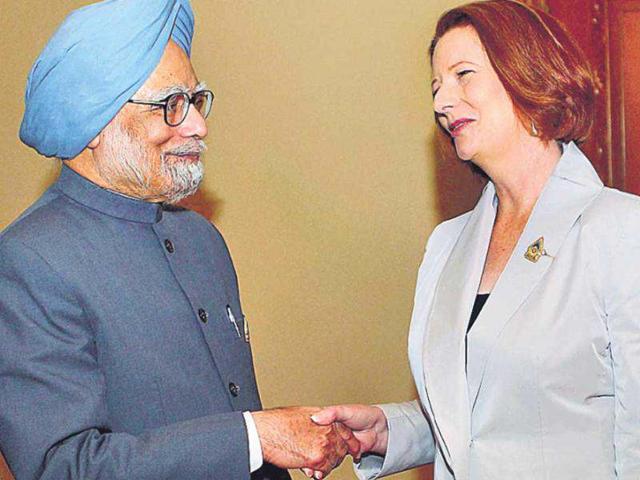The right way forward
India and Australia have more in common than other nations. A new report suggests how they can further strengthen their ties, write Amitabh Mattoo and Ashok Malik.
As flanking States in the eastern Indian Ocean, India and Australia are critical to this emerging arena of geopolitics. Fellow democracies with shared values, concerns and interests, they should have strong synergies. Yet, somehow the strategic outcomes have been sub-optimal.

To examine why - and make appropriate recommendations - the Australia India Institute (AII), University of Melbourne, put together a six-member bilateral Taskforce on Perceptions nine months ago. Its report, titled 'Beyond the Lost Decade', was released by the Indian high commissioner in Sydney recently, and points to a piquant paradox. Australia and India have more in common than many other countries - but these commonalities themselves tend to inhibit how the two societies see each other.
Cricket, the Commonwealth and the English language, the report says, have proved both a blessing and a bane. In its own way, each framework has hindered either country's perception. In admiring Australia's cricket team, Indians are exposed to its sporting ethic, but also to the one national institution that is perhaps least reflective of the multiculturalism and ethnic diversity of contemporary Australia. This leaves many Indians innocent of just how integrated Australia is with Southeast Asia today. To extend the analogy, the ministry of external affairs (MEA) is itself unsure as to where Australia fits in with the Asian strategic calculus.
For Australia, the Indian establishment's dexterity with the English language has been appealing but also misleading. "In the view of some Australian scholars of India," the Taskforce says, "the elite's fluency in English has acted as a barrier to deeper Australian familiarity with the country, creating the illusion that understanding Indian languages and culture - unlike their Indonesian, Japanese and Chinese equivalents - is unnecessary."
When it comes to the Commonwealth, India and Australia are members of a multilateral club searching for a modern idiom and a raison d'être. As the club's heavyweights they are best suited to providing this, but have studiously avoided any meaningful conversation on the Commonwealth's future. As the Taskforce recommends, the MEA's new Development Partnership Administration Division and AusAID could "combine and contribute financial, material or human resources" for humanitarian assistance and technical capacity-building projects in third countries, beginning with "less-developed States of the Commonwealth".
There is a hard-power dimension to such cooperation. In the absence of support from within the Commonwealth, smaller member-states will inevitably turn to emerging powers outside the club for technical capacity and economic assistance. India and Australia are addressing this issue separately. The point is will they be better served addressing it in conjunction?
Since the end of the Cold War, the India-Australia relationship has had several false starts. Maritime cooperation was being discussed in even the early 1990s but accidents intervened - Canberra's overstated response to the Pokhran 2 nuclear tests; a decade later, the clumsy dismantling of the Quadrilateral (the fledgling partnership between the two countries and the US and Japan); the uranium issue, settled only in late 2011 when Australian Prime Minister Julia Gillard overcame opposition from domestic anti-nuclear lobbies and agreed to sell uranium to India.
Both countries need to be watchful, lest this history becomes an all-purpose excuse for not showing diplomatic urgency. Neither should problematic episodes become triggers for extreme interpretation. For example, it would be unfair if the legal quagmire and payment delays Australian contractors have faced, often for no fault of their own, following the 2010 Commonwealth Games in New Delhi were to influence the entirety of Australian business perception of opportunities in India.
Likewise, the street violence against Indian students in Melbourne and other cities in 2009-10 was deplorable but it can't take away from the fact that Australia remains a welcoming home for thousands of Indian migrants. Authorities in Australia have responded by cracking down on dubious educational institutions, and facilitating those students genuinely seeking education.
Nevertheless, the Taskforce recognises the troubling legacy of the period. It has recommended that "as an act of goodwill... visas of Indian students who were in Australia on February 8, 2010, and whose pathways towards permanent residency in Australia were affected by changes to immigration regulation in that year" be extended "for at least 12 months from December 31, 2012".
The broader questions are for India to ponder. From energy security to food security, intelligence sharing on terrorism to joint exercises of Special Forces, naval and anti-piracy coordination to constructing a new architecture for the Indo-Pacific (the confluence of the eastern Indian Ocean and the western Pacific), the canvas for Canberra and New Delhi is vast. It is also contingent on India expanding the scope of its Look East policy to Australasia.
A sense of an overarching doctrine for India's deep Indian Ocean thrust, and political ownership in New Delhi of such a doctrine, is still awaited. A start could be made by expediting the overdue territorial restructuring of the MEA and, as the AII Taskforce recommends, splitting the 26-nation Southern Division, "hiving off part of its mandate to a newly-constituted Indo-Pacific or Australasia Division" that could include Australia, New Zealand, Fiji and the Pacific Islands.
Amitabh Mattoo is director, Australia India Institute (AII), University of Melbourne; Ashok Malik was a member of the AII Taskforce on Perceptions
The views expressed by the authors are personal





